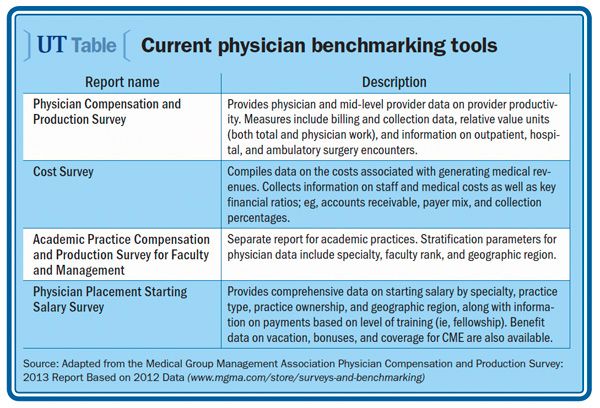Article
Fair compensation: How to achieve what you deserve
In this article, Deepak A. Kapoor, MD, provides an overview of existing benchmarks used in determining physician compensation and basic tools that can assist in the negotiating process.

Although many physicians feel that the outlook for medical practice is bleak, a number of current market forces suggest that the outlook for the specialty of urology is good:
- There are already too few urologists in the United States.
- The attrition rate for urologists leaving practice through death or retirement exceeds the number of physicians graduating from residency programs. As urology is the second oldest specialty in the United States, we can anticipate that this trend will continue.
- As the population ages, the need for urologic services will increase. An estimated 10,000 baby boomers become Medicare eligible every day.
That said, a combination of factors has put increased pressure on independent physicians. Practice expenses continue to increase, exacerbated by regulatory burdens and the costs of acquiring improved information technology infrastructure required by meaningful use mandates. The complexity of managing a medical business coupled with declining reimbursements has led to increased consolidation of urologists into larger single-specialty and multispecialty group practices. However, not every market has the population density to support this integration, which has prompted many physicians to sell their practices. A larger percentage of graduating residents are seeking hospital employment as well.
Unfortunately, many urologists either in practice or entering practice are unaware of fundamental negotiating techniques, which may put them at a disadvantage in the negotiations process. The purpose of this article is to provide an overview of existing benchmarks used in determining physician compensation and basic tools that can assist in the negotiating process.
Next: Existing practice benchmarks
You might also like:
Are you using the right physical exam templates?
Circumcision error leads to Peyronie's disease
Initiatives open up patient access to their health info
Existing practice benchmarks
The most commonly used physician benchmarking tools are produced by the Medical Group Management Association in conjunction with the American College of Medical Practice Executives. The MGMA-ACMPE database is derived from annual questionnaires sent to physician practice groups of different types, including single- and multispecialty groups both with and without academic affiliation. The results of these questionnaires are published annually in a series of reports. Although a number of different reports are available, the four reports most important to physician negotiation are as follows:
- Physician Compensation and Production Survey: This report provides physician and mid-level provider data on provider productivity. Measures include billing and collection data, relative value units (RVUs; both total and physician work), and information on outpatient, hospital, and ambulatory surgery encounters.
- Cost Survey: This survey compiles data on the costs associated with generating medical revenues. Information is collected on staff and medical costs as well as key financial ratios such as accounts receivable, payer mix, and collection percentages.
- Academic Practice Compensation and Production Survey for Faculty and Management: MGMA recognizes that considerations in academic centers may differ from those in private practice; as such, the organization prepares a separate report for these sites of service. Stratification parameters for physician data include specialty, faculty rank, and geographic region.
- Physician Placement Starting Salary Survey: MGMA conducts this survey in collaboration with the National Association of Physician Recruiters. Comprehensive data on starting salary are available by specialty, practice type, practice ownership, and geographic region, along with information regarding payments based on level of training (ie, fellowship). Benefit data on vacation, bonuses, and coverage for CME are also available.
Next: Understand benchmark tools' limitations

These reports are commercially available, and can be purchased in print and online versions (see www.mgma.com/store/surveys-and-benchmarking). They may also be found in many institutional libraries. As many institutions and practices will utilize these reports as absolute standards in determining physician compensation (including base compensation, bonus structure, and benefits), it may be of value for the practitioner to personally obtain the relevant data to validate the accuracy of the information. Although the questionnaires used are very robust and the data are subject to a detailed review and analytic process, the reports are not without limitations, and it is important that physicians understand these limitations:
- The survey is limited to MGMA-ACMPE members and, as such, may not be representative of all medical practices.
- Not all MGMA practices have the necessary resources to respond. For example, the cost survey is comprised of 137 detailed questions; although completion of the survey qualifies for 6 hours of CME credit from ACMPE, the actual time to completely fill out the questionnaire may be much longer.
- The survey response is voluntary. Not all practices complete all questions and independent verification of the answers is difficult.
- The data are collected once per year and published toward the end of the following year, making the data almost 2 years old by the time the report is released.
The relatively small size of urology as a specialty and the diverse number of practices amplify some of these limitations. An example of this can be seen in the differential in response rates for total physician compensation versus RVU data in academic institutions: although there are 122 listed institutions with urology residency programs, the data for total physician compensation has 30 institutional responses, and RVU data from that same site of service has only 18 institutional responders. Similar issues are seen in private practice: 40 single-specialty group practices comprising 254 physicians (mean, 6.35 physicians per group) responded to physician compensation data, but 30 practices comprising 106 physicians (mean, 3.53 physicians per group) provided RVU data; it’s hard to determine the impact that dropping 10 larger practices from the mix has on the validity of the data.
Negotiation strategies
Given the limitations of physician benchmarking tools, physicians may have some leeway in contract discussions. Whether you’re in solo or group practice, either as part of a consolidation strategy or sale to a hospital, these five simple steps can help ensure that you achieve the compensation you deserve.
Do your homework. It is vital that the physician understand what the acquiring entity hopes to gain from the association. Is it market share, increased surgical referrals, control of ancillary services, competitive parity, or some other consideration? Is there a special skill set that the hiring entity needs? What other options exist? How are physicians in the organization treated and are they generally happy? In contract negotiations, information is power; understanding the needs of the other party enables you to leverage that knowledge to your advantage.
Understand your value. Larger business entities have the resources to acquire data, so expect that they will present the data in a fashion that puts the physician at a disadvantage. Make certain that you are clear on your global value; that value is not confined to the number of clinic visits and surgical cases that you may do. Whether it is advanced imaging, clinical or anatomic pathology, or referrals to radiation or medical oncologists, urologists spin off far more services than they themselves perform. By the same token, be honest with yourself. If you do not have a unique skill set or if the market is very competitive, your leverage will be lower. Understanding your true fiscal worth will greatly impact how you view an offer.
Know your reimbursement metrics. In many cases, RVUs are used as the measure of performance, yet remarkably, many physicians do not understand how the RVU for a given procedure is assigned. For each CPT code, there are three components: physician work, practice expense, and malpractice costs. The basic values are standard nationally, and different values for practice expense are assigned to physician offices and facilities.
To compensate for regional variations, each Medicare locality is assigned an adjustment for each of the three components. These are known as the Geographic Practice Cost Index (GPCI; colloquially referred to as “gypsies”). Therefore, the total RVU value for each procedure is the sum of the product of each of the three RVU components with its corresponding local GPCI.
Even though the use of RVUs to measure productivity is ubiquitous, they are not necessarily precise. Since RVUs are usually standardized regardless of payer, in situations where there has been advantageous contracting, using RVUs may actually undervalue the physician’s contribution to the bottom line. Furthermore, RVUs are not static. From year to year, the amount of RVUs assigned to any given procedure may well change, and this change is usually negative. In fact, given that there are multiple parameters in computing an RVU, it is possible for physicians may see a “stealth” reduction in productivity even if they are working harder! Physicians can protect themselves from these fluctuations by fixing their RVU valuation to an index year.
Another reimbursement methodology is to base compensation on either gross or net revenue generated. Just as RVUs may undervalue physician services when there are advantageous contracts, it may take an inordinate amount of work to generate income when there are disadvantageous contracts. In addition, factors such as overhead costs and billing efficiency, which may not be in the physician’s control, can substantially affect the bottom line. As a consequence, great care should be taken when entering into a compensation arrangement that is based on revenues or profitability.
Next: Don't overlook terms of agreement
Don’t overlook the terms of the agreement. Often physicians are seduced by very attractive short-term arrangements, only to find themselves at the short end of the stick when the initial contract period is over. Make sure the length of the arrangement is in your favor. In situations where the physician will be able to grow a practice and increase revenues, a shorter duration contract that can be negotiated upwards is advisable; a longer term deal is favorable when there may be downward pressure on either volume or payment or if the physician is closer to retirement. Although typical institution contracts average around 3 years, try to establish parameters for any subsequent contracts up front to safeguard against drastic future reductions or to give yourself an out before the initial term is up.
Most important, look at the track record of the institution, and beware of hospitals that historically slash subsequent contracts and practices that have a “churn-and-burn” history with new associates. Having a solid professional network within the urology community is imperative in order to obtain this information accurately. This is where the relatively small size of our specialty works to the physician’s advantage; virtually every urologist in the United States is within one to two degrees of separation from each other.
Know what you want. This is by far the most important item to bear in mind. Whether it is lifestyle, income, independence, academic status, research, security, benefits, or other parameters, having a genuine understanding of your own needs is paramount to any negotiating process. This is particularly true when a third party (such as a contract attorney) is acting on your behalf. Although your representative is there to protect your interests, he works for you, not the other way around. Make sure your agent understands what is important to you and doesn’t drag out negotiations for what may be irrelevant details.
Conclusion
In today’s health care market, regardless of the direction of health care reform, accurate and timely benchmarking is a critical component to success as providers work to grow their business and stay ahead of troublesome trends that could hurt their performance. While the demographics of health care in the United States are favorable to urologists, we must be involved and engaged in a variety of processes to secure proper physician compensation, create economic partnerships with hospitals, and support contract negotiations.UT
Subscribe to Urology Times to get monthly news from the leading news source for urologists.

















